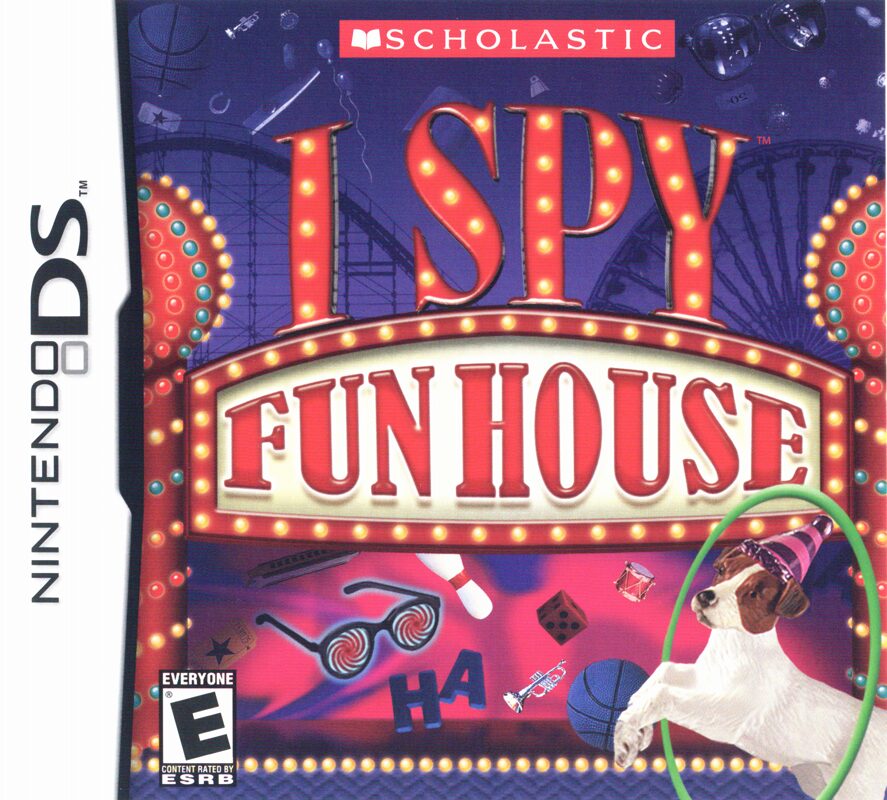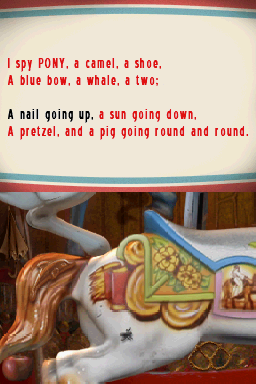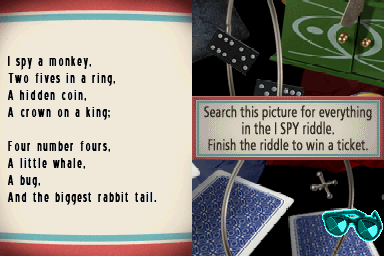Retro Replay Review
Gameplay
I Spy: Fun House delivers a classic hidden‐object experience wrapped in an amusement‐park theme. On each screen, you’re presented with a whimsical scene—from roller coasters to fun‐fair stalls—and a short verse at the bottom hints at the items you must uncover. Objects aren’t merely static; once clicked, they animate or shift slightly, confirming your success and adding a playful touch to each discovery.
(HEY YOU!! We hope you enjoy! We try not to run ads. So basically, this is a very expensive hobby running this site. Please consider joining us for updates, forums, and more. Network w/ us to make some cash or friends while retro gaming, and you can win some free retro games for posting. Okay, carry on 👍)
Progression hinges on collecting tickets, which serve as both reward and key. Ten tickets grant you access to the Fun House itself, while extras unlock a library of mini‐games. These bonus challenges range from tile-matching on concentric circles to fitting tetromino shapes into tight boxes and spotting subtle differences between near-identical pictures. With no time limits, penalties, or hints, gameplay encourages exploration and patience instead of frantic clicking.
The Windows/Mac version stands out for its breadth of content, including a promotional mini-disc featuring riddles from earlier I Spy titles by Walter Wick. The Nintendo DS port streamlines the experience: fewer mini-games, lower‐resolution art, and a slightly reduced ticket count (ten instead of eleven). The DS’s touchscreen makes object selection intuitive, though small screens can sometimes obscure tiny details. Across platforms, the learning curve is gentle, making it ideal for younger players or those new to hidden‐object puzzles.
Graphics
Drawing inspiration from the photographic collages of Walter Wick’s books, I Spy: Fun House boasts richly detailed scenes filled with layered objects and vibrant colors. On PC and Mac, each backdrop is crisp and textured, inviting you to zoom in and inspect every corner of the park. Subtle animations—like twinkling lights or moving Ferris wheels—breathe life into the environments without distracting from the core search.
The Nintendo DS version offers a charming, albeit scaled-down, presentation. While details are less pronounced and certain visual cues are simplified, the handheld’s bright screen and stylus control maintain the spirit of discovery. Mini-games adopt a clean, schematic look that contrasts with the photographic search areas but remains clear and legible even on the smaller display.
Menus and interface elements are straightforward and kid-friendly. Verses appear in a readable font at the bottom of each scene, and your ticket count is always visible. Animations upon selecting correct items—such as a confetti burst or object glow—are small but satisfying touches that reinforce successful play. Overall, the visuals strike a balance between whimsy and clarity, ensuring players know exactly which objects they’ve found.
Story
While I Spy: Fun House isn’t driven by a traditional narrative, it weaves a light thematic thread through its amusement-park setting. Each hidden‐object scene represents a different attraction—carnival games, a spooky tunnel, a carousel—and the recurring goal of uncovering hidden tickets gives you a sense of adventure. The verses at the bottom read like playful rhymes that encourage observation and spark curiosity.
The ticket mechanic injects a meta-storyline of progression: find enough tickets to unlock the titular Fun House, where the most challenging searches await. Along the way, mini-games serve as thematic pit-stops, offering variety and reinforcing the carnival motif. Although there are no characters or cutscenes, the structure of “find, collect, unlock” provides its own loop of anticipation and reward.
For fans of the I Spy book series, the inclusion of a mini-disc with riddles from earlier titles adds a nostalgic flair to the Windows/Mac release. On the DS, the streamlined ten‐ticket goal and the promise of exiting the Fun House creates a clear endpoint. Both versions emphasize playful exploration over deep storytelling, making them accessible to casual gamers and young children seeking bite-sized puzzles.
Overall Experience
I Spy: Fun House offers a delightful blend of hidden‐object searches and light puzzle mini-games wrapped in a cheerful carnival motif. The absence of time pressure and wrong-click penalties makes for a relaxed experience, perfect for family play or solo sessions with younger children. Collecting tickets fuels a gentle sense of progression, while variety in mini-games keeps gameplay from feeling repetitive.
The Windows/Mac edition stands out for its richer content and crisp visuals, plus the bonus mini-disc riddles that expand the I Spy universe. The Nintendo DS version trades some polish for portability and touchscreen convenience, delivering a similarly engaging experience but with fewer screens and simplified graphics. Both editions cater well to their respective platforms and audiences.
Ultimately, I Spy: Fun House shines as a charming, approachable title that emphasizes observation skills and patience over reflexes or complex mechanics. It’s an excellent choice for parents seeking educational entertainment, fans of the classic I Spy books, or casual gamers looking for a low-stress puzzle collection. While it may not satisfy those craving deep narratives or high-octane challenges, its colorful presentation and steady progression ensure that little detectives will remain engaged from the carousel to the grand finale.
 Retro Replay Retro Replay gaming reviews, news, emulation, geek stuff and more!
Retro Replay Retro Replay gaming reviews, news, emulation, geek stuff and more!









Reviews
There are no reviews yet.